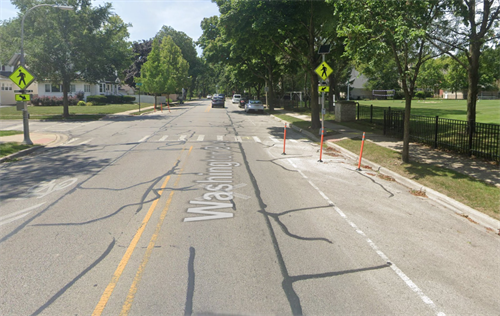Washington Boulevard – Project Background
Washington Boulevard is a 2-Lane bidirectional Major Collector in the Village of River Forest. The Average Daily Traffic (ADT) as of 2022 is 5,700 vehicles with a posted speed limit of 25 Miles Per Hour (MPH). Speed limit signs are posted for both directions periodically through the corridor including a driver feedback sign for eastbound drivers. There is striped on-street parking provided on both sides of the road throughout the corridor. Washington Boulevard is designated as a bike path within the Village. Bike facilities along Washington Blvd include on-street pavement markings for shared lane usage but no dedicated bike lane. In total there are two signalized intersections, two all-way stop intersections, and four minor leg stop intersections where Washington Blvd is the non-stopping route.
The Village has received significant feedback regarding speeding along the corridor of Washington Blvd and considering a past study's findings that parking was severely underutilized throughout Washington Blvd the Village Traffic and Safety Commission wanted to consider either a road diet or installing other traffic calming measures to mitigate speeding. In 2023 the Village commissioned a Village-wide traffic study to review traffic conditions throughout the Village. This study also provided for a detailed review of conditions on Washington Boulevard and suggestions for future improvements.
Washington Boulevard – Project Development
The Village Wide Traffic Study reviewed Washington Boulevard in depth due to existing concerns. Volumes were gathered for the peak hour times of three intersections throughout the corridor. The intersections were chosen to get a good representation of where drivers enter and exit the road. The three intersections chosen were the two primary intersections (Thatcher Ave and Lathrop Ave) and the third counted intersection was Franklin Ave at Washington Blvd which was chosen due to the signalization and five leg geometry. Speed data was taken at the midway point of the corridor near the railroad overpass. This location was deliberately analyzed away from stopping intersections to ensure that the speed of drivers in the corridor was not impacted by traffic stopping/slowing to turn onto intersections. In traffic engineering the 85th percentile is expected to be the speed limit of a road. Seeing 85th percentile speeds significantly above the speed limit could indicate that road conditions do not reflect the posted speed limit. The average 85th percentile speed along Washington Blvd across all time periods was 38 mph. This was 13 mph above the posted speed limit. Based on these speeds the consultant recommended making changes to either geometry or operating conditions to force drivers to travel at safer speeds. At the AM and PM peak hour times the 85th percentile speed was 15 mph above the posted limit. This indicates that even during the peak periods traffic conditions do not slow drivers down. The high speeds coupled with higher volumes at the peak hour make the road much more dangerous for pedestrians, bicyclists, and cross-street vehicular traffic.

Based on this analysis, the Village implemented immediate traffic calming measures in April 2024 in the form of traffic delineators at each intersection. Traffic calming delineators are used to visually guide drivers, helping them navigate road changes, thereby encouraging slower speeds and safer driving behavior; essentially, they act as visual cues to alert drivers to potential dangers and encourage them to adjust their driving accordingly. These delineators are removed during the winter season due to snow operations, but will be put back each Spring. After leaving the delineators in place the Village requested the consultant review the previous speed counts and provide an analysis of the impact of the delineators. Based on the results of the speed collection, the consultant noted a drop in 85th percentile speed between 4-7 mph below the original 2023 speed data. Considering the roadway remains the same excluding some visual barriers (plastic bollards), this is a notable reduction in speed.
These delineators have provided traffic calming to the corridor while a long-term improvement is established. The Washington corridor improvements would provide a connection point to the future Thatcher bike trail and three local parks along the route. Additionally, the project includes a road diet, bump outs, ADA improvements, and various other traffic calming measures that contribute to bicycle and pedestrian safety. The Village applied for Illinois Transportation Enhancement Program (ITEP) grant funding in September 2024 but was unsuccessful in obtaining this grant. The Next ITEP funding application cycle is in August 2026 which the Village will submit Washington Boulevard. In March of 2025, Village Staff submitted a grant application to Cook County’s Invest in Cook grant program for potential funds for the completion of a Phase I for the Washington Corridor. The Village was notified of the award on July 25, 2025. The County shall reimburse the Village up to $62,786 for Phase I engineering costs. The project is estimated to be $1,785,906.15 including Phase 1 & 2 engineering along with construction and construction engineering.
Community Meeting
The Village of River Forest will be holding a Community Meeting Thursday, November 6th between 4 pm and 7 pm at 7901 Washington Boulevard in Washington Square Park. In the event of inclement weather, the Open House will be moved to the Public Works Garage at 45 Forest Avenue. You are invited to attend an open house to learn more about the project.
Projected Project Schedule
Phase I Preliminary Engineering – Start approximately August 2025
A Phase I Study consists of a Preliminary Engineering and Environmental Study which provides the support for the determination of a preferred option. During this phase, proposed geometry, environmental concerns, and proposed right-of-way are identified and public hearings are held to solicit feedback regarding the project.
Phase II Detailed Engineering – Start approximately July 2026
Phase II is the Design phase which refines the design and develops Plans, Specifications and Estimates for construction.
Phase III Construction – Start approximately May 2027
Phase III refers to the construction phase of a project, which is the final stage where the actual building and implementation of the planned improvements take place.